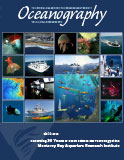Article Abstract
Chemical sensor development has been a focus for the Monterey Bay Aquarium Research Institute (MBARI) from its inception. Progress in chemical analyzers benefited from technological advances in many fields. MBARI’s development of a low power, reagent-free, in situ ultraviolet spectrophotometer (ISUS) for measuring dissolved nitrate has been transformative. These ultraviolet optical nitrate sensors have been deployed on remotely operated vehicles, autonomous underwater vehicles, benthic flux chambers, profiling floats, and moorings. This paper focuses on a 15+ year time series of nitrate observations on MBARI’s M1 mooring in Monterey Bay, California. The resulting data set captures seasonal and interannual variability from El Niño and La Niña, and water mass anomalies on the eastern boundary of the Pacific Ocean. The high temporal resolution (hourly) nitrate measurements additionally quantify diel cycles of nitrate uptake as a proxy for new production. The calculated f-ratio varies seasonally with relatively higher values during the lower productivity winter season. The physical supply and uptake of nitrate are dominated by upwelling in this coastal environment. An expanding number of ultraviolet optical nitrate sensor deployments on moorings and autonomous platforms such as profiling floats will provide ever-broadening coverage of the world ocean, resulting in enhanced spatial and temporal resolution of nitrate measurements and, ultimately, improved insight into the dynamics of nitrogen cycling and phytoplankton ecology throughout a changing global ocean.

